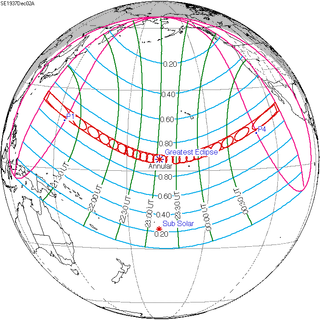| Solar eclipse of December 2, 1937 | |
|---|---|
| Type of eclipse | |
| Nature | Annular |
| Gamma | 0.4389 |
| Magnitude | 0.9184 |
| Maximum eclipse | |
| Duration | 720 s (12 min 0 s) |
| Coordinates | 4°00′N 167°48′W / 4°N 167.8°W |
| Max. width of band | 344 km (214 mi) |
| Times (UTC) | |
| Greatest eclipse | 23:05:45 |
| References | |
| Saros | 141 (19 of 70) |
| Catalog # (SE5000) | 9370 |
An annular solar eclipse occurred at the Moon's ascending node of orbit between Thursday, December 2 and Friday, December 3, 1937,[1] with a magnitude of 0.9184. A solar eclipse occurs when the Moon passes between Earth and the Sun, thereby totally or partly obscuring the image of the Sun for a viewer on Earth. An annular solar eclipse occurs when the Moon's apparent diameter is smaller than the Sun's, blocking most of the Sun's light and causing the Sun to look like an annulus (ring). An annular eclipse appears as a partial eclipse over a region of the Earth thousands of kilometres wide. Occurring only about 18 hours before apogee (on December 3, 1937, at 16:50 UTC), the Moon's apparent diameter was smaller.[2]
The duration of annularity at maximum eclipse (closest to but slightly shorter than the longest duration) was 12 minutes, 0.33 seconds in the Pacific Ocean. It was the longest annular solar eclipse since December 25, 1628, but the Solar eclipse of December 14, 1955 lasted longer.[3]
Annularity was visible from Ogasawara, Tokyo and South Seas Mandate (the part now belonging to Marshall Islands) in Japan, and Gilbert and Ellice Islands (the part now belonging to Kiribati). A partial eclipse was visible for parts of East Asia, northern Oceania, Hawaii, and western North America.
- ^ "December 2–3, 1937 Annular Solar Eclipse". timeanddate. Retrieved 3 August 2024.
- ^ "Moon Distances for London, United Kingdom, England". timeanddate. Retrieved 3 August 2024.
- ^ "Annular Solar Eclipses with Durations Exceeding 11m 00s: -3999 to 6000". NASA Eclipse Web Site.
